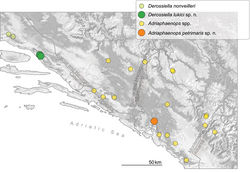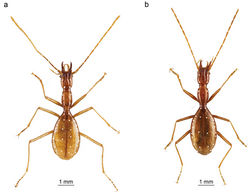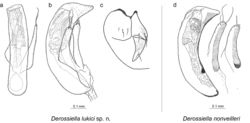Derossiella lukici
| Notice: | This page is derived from the original publication listed below, whose author(s) should always be credited. Further contributors may edit and improve the content of this page and, consequently, need to be credited as well (see page history). Any assessment of factual correctness requires a careful review of the original article as well as of subsequent contributions.
If you are uncertain whether your planned contribution is correct or not, we suggest that you use the associated discussion page instead of editing the page directly. This page should be cited as follows (rationale):
Citation formats to copy and paste
BibTeX: @article{Lohaj2019DeutscheEntomologischeZeitschrift66, RIS/ Endnote: TY - JOUR Wikipedia/ Citizendium: <ref name="Lohaj2019Deutsche Entomologische Zeitschrift66">{{Citation See also the citation download page at the journal. |
Ordo: Coleoptera
Familia: Carabidae
Genus: Derossiella
Name
Derossiella lukici Lohaj & Delić, 2019 sp. n. – Wikispecies link – ZooBank link – Pensoft Profile
Type series
Holotype male labelled: “Croatia, Mt Biokovo, Golubinjak, Biokovka, -300 m, 24.6.2017, T. Delić lgt.” (white label, printed) / “DNA extraction RL–07” (orange label, printed) / “HOLOTYPUS Derossiellalukici sp. n. Lohaj & Delić des. 2018” (red label, printed), (CNHM, voucher code 600: ZAG; ZEC2, 4194 Coll. Jalžić). Paratypes: one female (right posterior tarsus missing) labelled: “Croatia, Mt Biokovo, Golubinjak, Biokovka, 2.9.2007, M. Lukić lgt.” (white label, printed) / “PARATYPUS Derossiellalukici sp. n. Lohaj & Delić des. 2018” (red label, printed), (CNHM, voucher code 600: ZAG; ZEC2, 4195 Coll. Jalžić)., one female (last three antennomeres of right antenna missing) labelled: “Croatia, Mt Biokovo, Lokva, Pretnerova, -120 m, 19.05.2015, E. Premate lgt.” (white label, printed) / “PARATYPUS Derossiellalukici sp. n. Lohaj & Delić des. 2018” (red label, printed), (CRL).
Diagnosis
Medium-sized aphaenopsoid trechine with morphological features fully matching generic description proposed by Quéinnec (2008)[1]. Head long, parallel-sided, with complete, deep frontal furrows reaching neck constriction and two pairs of supraorbital setae, posterior setae doubled. Eyes absent, mentum with simple tooth. Aphaenopsoid habitus with very narrow head and pronotum; elytra oblong-oval, 2.6 times wider than head and pronotum. Hind angles of pronotum without setae. Surface completely glabrous, striae absent, elytral chaetotaxy with macrochetae and microchetae. Cuticle depigmented, reddish-yellow, body strongly flattened dorso-ventrally, with very long and slender legs and antennae (Figs 3, 4). Closely related to the type species of the genus, Derossiellanonveilleri, from which it differs by paired posterior supraorbital setiferous punctures, differently shaped elytra with higher number of macro- and microchetae, narrower pronotum, as well as by the differently shaped aedeagus.
Description
L: 5.5 mm (PT)–6.0 mm (HT), TL: 4.8 mm (PT)–5.4 mm (HT). Head relatively large, nearly parallel-sided, with maximum width behind middle, distinctly longer than wide (index HL/HW 1.35 (PT)–1.42 (HT), slightly wider than pronotum, sparsely pubescent. Frontal furrows deep, complete, reaching neck constriction, slightly divergent posteriorly. Anterior pair of supraorbital setae situated before middle of head length, posterior supraorbital setae paired, two setae on each side of head situated close to neck constriction. Neck constriction distinct; genae gently convex. Clypeus and labrum with three pairs of setae, outer pairs longer. Antennae length 4.9 mm (HT)–4.3 mm (PT), scape as long as pedicel, almost as long as terminal antennomere.
Pronotum elongated, slightly longer and narrower than head, with maximum width in anterior third, index PL/PW 1.75 (PT)–1.83 (HT), only slightly narrowed anteriorly, posterior part distinctly narrower than anterior. Surface glabrous, median furrow distinct, visible in whole pronotal length. Propleura visible from dorsal aspect in basal two-thirds. Anterior angles of pronotum not protruding, posterior angles obtuse. Lateral furrows well developed, deep, with one pair of anterolateral setae, situated in the apical fifth of pronotal length.
Elytra subovate elongate, distinctly longer than wide, index EL/EW 1.74 (PT)–1.85 (HT), with maximum width in posterior third; elytral surface glabrous, without pubescence; striae absent. Stria 3 with 4–5 (3–4 discal and one preapical) macrochetae and 3 or 4 microchetae situated between macrochetae, stria 5 with 4 or 5 microchetae (Fig. 4). Humeral group of umbilicate pores not aggregated, first anterior pore of humeral group isolated and situated at level of the first discal seta.
Legs long, slender, densely pubescent. First two tarsomeres of male protarsi distinctly dilated and protracted at their internal margins. Tarsal claws very long and slender, without traces of denticulation on their internal sides.
Male genitalia. Aedeagus (Fig. 5) 0.58 mm long, relatively robust, regularly wide, lacking apical constriction, laterally flattened. Parameres relatively long and slender, longer than half of the length of aedeagus. Apex very short, tip obtuse. Each paramere at apex with three setae, two long, and one short.
Female genitalia as in Figure 5.
Etymology
Patronymic, dedicated to our dear friend Marko Lukić (Zagreb, Croatia), enthusiastic speleologist and speleobiologist, taxonomic specialist on subterranean Collembola, and collector of the first specimen of the new species.
Differential diagnosis
Derossiellalukici sp. n. is closely related to the type species of the genus, Derossiellanonveilleri. However, these two species can be easily recognized using the following key:
Distribution
So far this species is known from the two pits on Mt Biokovo, the type locality, Biokovka, Golubinjak and Pretnerova jama, Lokva. All three specimens were found in deeper parts of the caves, attaining depths of 120 to 300 m. They were all found walking on the “moonmilk”, a white, pastelite material consisting of microbiologically transformed microcrystalline calcites with high water content (60–90%), and near the cave hygropetric.
Associated subterranean coleopteran fauna observed in the pits:
1 Biokovka, Golubinjak, Biokovo, Croatia:
Carabidae: Trechinae
Neotrechusdalmatinus (Miller, 1861)
Leiodidae: Cholevinae
Leptomesonbiokovensis Giachino, Bregović & Jalžić, 2012
Radziellastyx Casale & Jalžić, 1988
Speoplanesgiganteusbiocovensis Müller, 1934
2 Pretnerova jama, Lokva, Biokovo, Croatia:
Carabidae: Trechinae
Dalmataphaenopschiarae Monguzzi, 1993
Carabidae: Sphodrini
Laemostenuscavicola (Schaum, 1858)
Leiodidae: Cholevinae
Leptomesonbiokovensis Giachino, Bregović & Jalžić, 2012
Radziellastyx Casale & Jalžić, 1988
Speoplanesgiganteusbiocovensis Müller, 1934
Staphylinidae: Pselaphinae
Pselaphinae gen.
Original Description
- Lohaj, R; Delić, T; 2019: Playing hard to get: two new species of subterranean Trechini beetles (Coleoptera, Carabidae, Trechinae) from the Dinaric Karst Deutsche Entomologische Zeitschrift, 66(1): 1-15. doi
Images
|
Other References
- ↑ Quéinnec E (2008) Two new genera and species of ‘aphaenopsid’ cave beetles from the Balkan Peninsula and considerations about the evolutionary trends of the so-called “hyper-specialised” trechines. In: Pavićević D Perreau M (Eds) Advances in the Studies of the Fauna of the Balkan Peninsula.Institute for Nature Conservation of Serbia, Belgrade, 157–176.



